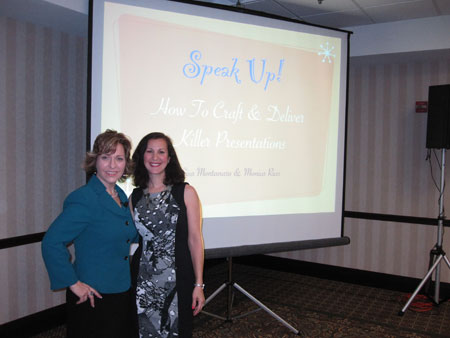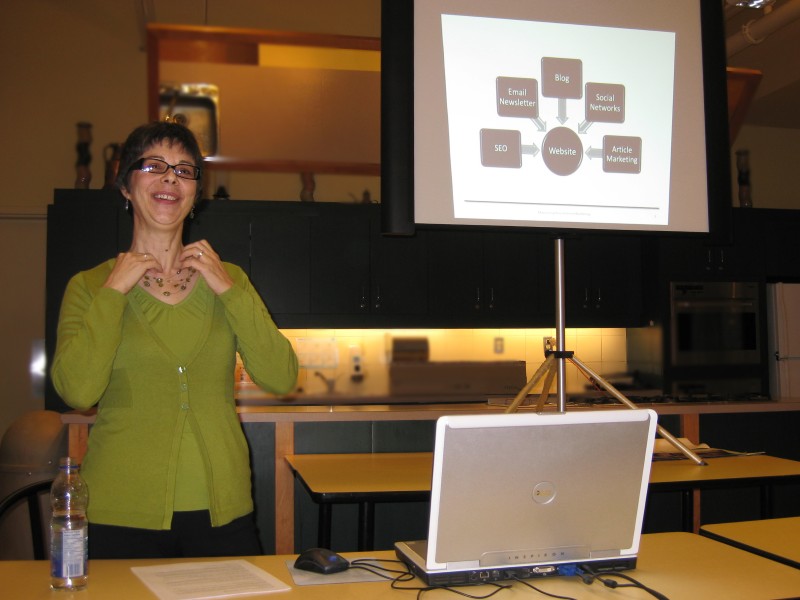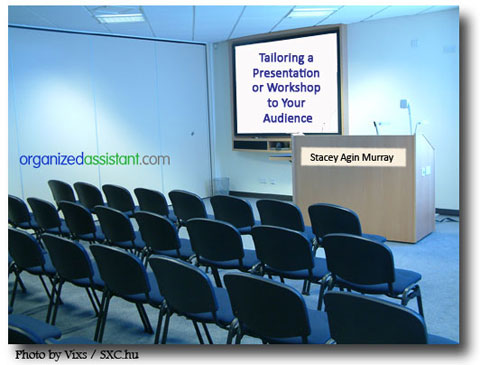Making the Best Impression with Your Presentation
This page may contain links to Amazon.com or other sites from which I may receive commission on purchases you make after clicking on such links. Read my full Disclosure Policy

Public speaking is a proven method for getting the word out about your business, but until you’ve tried it a few times, you may be concerned that your presentation skills aren’t up to snuff. I’m happy to bring you these 16 tips from Payman Taei.

As tough as it may be to accept sometimes, your idea is really defined by how well you present it.
Considering fear of public speaking is one of the most common phobias, it can mean that revolutionary plans can be lost before they even have a chance to get off the ground.
Those who rarely give formal presentations may spend too much time on one point while completely ignoring others. Experienced people may sound robotic or dull.
Regardless of where you start, if you want to make the best impression, you’ll need to do some careful preparation first.
1. Always Simplify
Just like your eyes would skip right over this paragraph if it were too long, your presentations need to contain short, powerful bursts of information.
Your visual tools should not be detailed wording in tiny print, and ideally you should be able to summarize each idea in under 20 words. Experts say you should limit your slides to 10, and your actual talking time to 20 minutes. Use 30-point font on your slides so the audience can easily absorb the message.
2. Use Stories to Teach
People have a difficult time recalling statistics, especially considering they’re a dime a dozen and often don’t represent the truth. Visme makes dry or complicated information come alive in a way that audiences will remember.
When incorporating storytelling techniques into your presentation, you need a way to visually represent your ideas. Visme makes it easy to achieve the exact visual impression you’re trying to make, whether it’s compelling research, a stunning photo or a news item.
3. Never Read Aloud
Reading from slides or a sheet of paper makes you look amateur, and your audience’s minds wander. Note cards aren’t necessary when you have the right visual tools that demand people’s attention, like colorful and concise graphics that clearly illustrate your points.
Your audience can read too, so your words should be supplementing and explaining what’s on the slides rather than repeating it.
4. Craft Stunning Visual Aids
 Charts and graphs have a place in presentations, but color, size, font and text matter just as much as the data they represent. There are a number of ways to put your presentation together, and your professional reputation is on the line if your slides are blurry, too small or just plain redundant.
Charts and graphs have a place in presentations, but color, size, font and text matter just as much as the data they represent. There are a number of ways to put your presentation together, and your professional reputation is on the line if your slides are blurry, too small or just plain redundant.
If you’re discussing data that needs to be explained in further detail, you may want to send infographics to participants after the presentation that delve deeper into the topic and reinforce your call to action.
5. Know Your Stuff
Your passion and expertise will count for a lot when it comes to having an impact on the people you talk to. However, knowing your stuff also means knowing what other people care about when it comes to your chosen topics.
You should only be covering facts that are of interest to them with real-world examples that directly relate to their professional plans.
6. Stay Flexible
Rigid people will immediately turn an audience off, and can inadvertently cause an adverse reaction in the room. This doesn’t mean you should let the presentation be derailed by off-topic chatter, but it does mean you should be ready to change directions if the situation warrants.
Pay attention to your audience when it comes to their body language and questions, and be ready to tweak if you’re not hitting home.
7. Never Lie
If you don’t know the answer, let the audience know right when the question is asked.
You should be able to give the questioner related information in lieu of a direct answer, which should help the group feel confident in accepting and implementing your advice.
8. Mix It Up
Your visual tools should keep people intrigued rather than just giving people something to glance at so it seems like they’re paying attention.
Part of this means using different means of communication, like polls, short videos, maps and even jokes. Visme has a wide array of options over more traditional cloud-based apps to turn your creativity into reality, and you can do it all right from your browser.
9. Practice Wisely
There is a point for everyone where practicing becomes counter-productive.
Some people will become much more apprehensive if they think too much about what they say and how they say it. Know yourself, and then set a course of action from there.
10. Watch Your Body
Your body language says a lot about who you are as a person, and your audience will pick up on it all (whether consciously or not.)
If you think raising your hand to emphasize your most important point will get you a standing ovation, you might be surprised at how lackluster the actual response will be.
The gestures you make should feel natural, meaning only raise your hand if you feel compelled to do so.

11. Use Eye Contact Effectively
Presenters often get so wrapped up in what they’re saying that they end up staring into one person’s eyes for longer than anyone else’s.
It’s understandable, but uncomfortable. Try to space out your eye contact as best as possible, and never stare at the wall or out the window.
12. Don’t Discriminate
Is there a secretary in the room who seems like she should be answering the phone? She may end up being the one to convince her manager that they should follow up with your ideas.
Don’t talk down to anyone or ignore them when you’re making the presentation. You never know who you might need in your corner one day.
13. Don’t Get Ahead of Yourself
Many of these tips focus on keeping your presentation short and sweet, but don’t assume you have to rush either. If you speak at a normal pace, in a clear and enthusiastic tone, people will hang on to your words.
If you’re rushing through because you’re nervous or don’t want to drift off point, people may become confused. Rehearsing in front of someone objective can prevent this problem.
14. Make The Best of Breath
Your breath can end up playing a key role in how you relate to the audience, because it can be what stops you from feeling nervous in the moment.
The second you feel yourself getting flustered is the second to take a deep breath and put yourself back in the game. Breaths can also be used in place of filler sounds like “Um” or “Ah”, making you sound much more knowledgeable and comfortable.
15. Use Time Wisely
Both in terms of planning and on the day of the presentation. Get there early and spend some time familiarizing yourself with the room. If you’re looking to maximize your time, then Visme can help.
Our clients note that our interactive presentation tools save them weeks of work, with tools that make it simple to customize the exact look they want.
16. Have a Great Time
The more fun you have, the more likely your presentation will leave an impression. It’s your chance to shine, so smile a little and don’t take your points too seriously.
The more presentations you do, the more you’ll hopefully understand where your strengths and weaknesses lie, so you can focus on only what needs fixing.
Photo © GeorgeRudy / DepositPhotos





I will tool around the Visme sight. I’m assuming this is an alternative to Power Point? I do a lot of presentations, and thought these points were terrific. I like to designate someone who will hold up a hand when I’m 10 minutes from “times up” to help me stay on track. This keeps my eyes up and on the audience instead of checking a clock or my screen.
Yes, you can use Visme to create PowerPoint-like presentations, as well as infographics and other visual marketing elements. It’s on my list of tools to try!
Great tips. I haven’t done presentations in years but I found that if I outlined my notes/presentation well and review it only a few times before the presentation day, I could wing the rest. I tend to be more stressed setting up the presentation than actually presenting.
I hadn’t thought of it that way, but me too! I’m always super anxious in the weeks leading up to a presentation, and not usually aware of what’s bugging me. But once I start talking, I nearly always have a lot of fun!
These are great tips! As someone who speaks frequently, I’m always looking for new way to share and engage my audience. My favorite though is the power of story – I may not remember the 5 points the speaker shared, but I will remember the story that tugged at my heart or brought me to tears! Wonderful post!
Yes! I am discovering the power of the story, whether it’s in a presentation, or a blog post, or elsewhere. It’s the one thing that sets the speaker/writer apart from everyone else.
Wonderful tips! I will take a close look at Visme. I always need help with graphics. This sounds like a terrific tool!
As an audience member, I think a speaker is better off with no visuals than with bad ones!
I speak at a senior living community once or twice a month. I’m always super nervous leading up to it, and still fairly nervous while up there speaking. I think the tips in this blog post will really help me! I just signed up for Visme and started my first presentation… thank you so much!
That’s awesome, Nicole – let us know how you make out!
Visme looks like a great tool. I’m accustomed to creating my seminars using PowerPoint, but it’s always fun to experiment with something else. I also agree that less words and more visuals are better. I am challenged by keeping the number of slides to 10, but pretty good about not overcrowding them and using lots of visuals. All of your points were excellent and I know they’ll help me going forward.
I agree with you – 10 isn’t very many! I guess the point is that the slides should serve only to enhance what we’re saying rather than being the focus of our presentation.
It also means we don’t have to spend as much time creating the slides! 😉
Such a helpful post! I’ll be speaking to my biggest audience yet in May where I’ll be presenting at a conference on hoarding with 300+ attendees. I’m a little intimidated by the number of people and I’ll be surely rereading this post! Definitely pinning. 🙂
That is a big group, Sarah, but you know your stuff – I’m sure you’ll do great. Thanks for pinning!
I like reading posts about this. For the past few years I had lots of practices. Good and bad. It’s always nice to see someone else’s point of view, tips, etc. Thank a lot. It is a good mix of straight to the point values.
Regards,
Dean
PR Expert